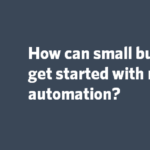
While the use of marketing automation is increasing in terms of the number of businesses using automation and the level to which those businesses are using it, what we do know if that adoption is faster among larger businesses.
A recent Raab Report found that 60 percent of those with revenues exceeding $500 million have already implemented marketing automation, but just 3 percent of small businesses with fewer than $5 million in revenue have invested in it.
Having said that, marketing automation presents many opportunities for small business to benefit from — including generating more leads and increasing customer value, making it an extremely important strategy for them to consider.
Consultant, Philip Storey, is adamant that SMEs embrace automation:
“Many of the SMEs that look into marketing automation in detail are driving a significant portion of their revenue from email marketing through automated strategies. They’re the ones that are really winning.”
Recent Gleanster analysis shows that the best performing small businesses start out simple by using email templates and out-of-the-box settings. The key is to improve these efforts over time. This approach was echoed by our webinar participants when we posed the question:
The key is to improve these efforts over time. This approach was echoed by our webinar participants when we posed the question: ‘How should SME’s get started with marketing automation?’
Digital marketing consultant, Gemma Went, suggested a simple process of connecting up your existing marketing channels and tools:
“If you already have an email platform, start to connect it up with your other online activities. If you have a Facebook Page, change your ‘Call to action’ button to ‘Sign up’ and direct them to your email list. Similarly, if you’re using Twitter, use the free Twitter cards and use the ‘Sign up’ card in the same way. If you don’t have a list, you need to start one.”
For best results, thinking about automation should extend beyond marketing. If small businesses are already automating emails and social media, the next logical step is to connect up their email list with their invoicing software.
Constant Contact integrates with tools like Xero, Freshbooks, FreeAgent and others. Start to create your own automated ecosystem and take the weight off your feet.
Philip Storey of Enchant extolled the virtue of website analytics to help you focus your attention on your most valuable automation opportunities:
“Look at your website and analyse the most common behaviours that could present you with opportunities to improve the customer experience. You might find that beyond basket abandonment, you can start to categorise types of browsing behaviours and create highly personalised automated responses to these situations.”
Whichever marketing automation approach you decide to start with, our panel were unanimous in their recommendation that you start with ‘baby steps’ and prove your case before automating further interactions.
Given that every business is different, this process of learning and iteration should be the defining strategy that underpins your initial forays into this innovative new marketing arena.
This whitepaper is free to download and features expert guidance about how small businesses can get started with marketing automation on a shoestring budget.
The post How can small businesses get started with marketing automation? appeared first on Constant Contact Blogs.
The post How can small businesses get started with marketing automation? appeared first on Red Mango Marketing!.